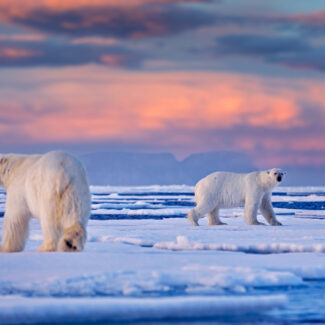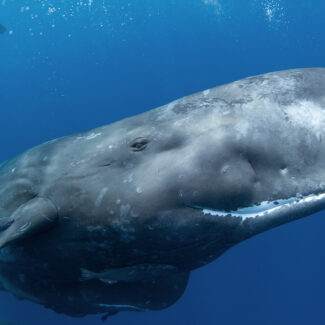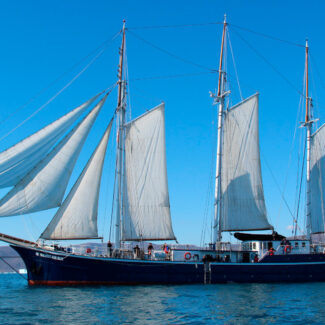Little America In Antarctica, Admiral Richard E. Byrd & Operation Highjump
Little America ranks among the defining placenames in the grand log of Antarctic exploration. It’s a moniker that was applied to a series of research bases established on the Ross Ice Shelf as part of expeditions helmed by U.S. naval officer Richard E. Byrd, which were among the largest and most intensive of their kind undertaken on the White Continent to date.
Richard Byrd and His Antarctic Expeditions
One of the legends of Antarctic exploration, Rear Admiral Richard E. Byrd made multiple trips to the Antarctic between the late 1920s and mid-1950s. Born in Virginia’s Shenandoah Valley in 1888, Byrd was to become a heavily decorated naval officer and high-profile polar explorer.
In 1926, he claimed to have made the first flyover of the North Pole, though whether his plane actually made it there has been debated ever since. (If Byrd didn’t actually fly to the North Pole that day, honors would go to the crew aboard the Italian airship Norge—among them another iconic Antarctic explorer, the Norwegian Roald Amundsen—which definitively reached the Pole only a few days after Byrd attested he did.)
The following year, Byrd achieved another notable feat with a nonstop trans-Atlantic flight.
But it was in the Antarctic that Byrd truly cemented his legacy, heading or helping head a series of expeditions that charted vast amounts of new territory in this most remote and inhospitable corner of the Earth.
Enduring the harsh Antarctic environment, Admiral Richard E. Byrd’s dedication to exploration defined an era of scientific discovery and human endeavor.
Little America I
Byrd’s first expedition, from 1928 to 1930, founded Little America as the first American base on the Ross Ice Shelf, the biggest of its kind in the world and lidding roughly 182,000 square miles (472,000 square kilometers) of the Ross Sea. The base was situated near the Bay of Whales, a natural ice harbor along the ice shelf first explored by Sir James Ross in 1842 and later used as a starting-off point by Roald Amundsen and companions to become the first to reach the South Pole.
This first expedition described new Antarctic terrain, including the Rockefeller Mountains and land beyond that the expedition leader would name for his wife: Marie Byrd Land. It also saw Byrd make the first flight over the South Pole, in a 19-hour out-and-back trip from Little America on November 29, 1929.
Joseph Rucker and Willard Vander Veer accompanied this first Byrd expedition and filmed a documentary, With Byrd at the South Pole, which landed an Academy Award in 1930.
Pioneering the skies of Antarctica, Admiral Byrd’s Fokker Super Universal at Little America I laid the groundwork for historic polar exploration.
Little America II
The second expedition Byrd led to the Antarctic, which took place from 1933 to 1935, used the same site as the first Little America as its base.
This project was notable for Byrd’s monthslong solo occupation of a weather station some 123 miles (196 km) to the south of Little America on the Ross Ice Shelf, in the winter of 1934-1935. He ended up suffering from acute carbon-monoxide poisoning, and might have died if not for the efforts of a rescue team sent out in arduous conditions.
Beyond the icy continent, Admiral Byrd’s diplomatic efforts for Little America II garnered crucial support, making continued scientific exploration possible and inspiring international collaboration.
Little America III: The Third Admiral Byrd Antarctica Expedition
Little America III, situated some seven miles (11 km) to the northeast of the original Little America camp, served as the base for Byrd’s third expedition, which was the first to be financed by the U.S. government: the United States Antarctic Service Expedition of 1939 to 1941, commissioned by President Franklin D. Roosevelt partly to strengthen a U.S. presence in the Antarctic amid the geopolitical posturing going down at the bottom of the world as World War II boiled.
This expedition also established another station, East Base, located on Stonington Island along the Antarctic Peninsula.
The United States Antarctic Service Expedition is also significant for the rather spectacular failure of the Snow Cruiser, a huge, tricked-out vehicle devised by Thomas Poulter—who’d been second-in-command during Byrd’s second Antarctic expedition—as a mobile base for Antarctic exploration. It proved being nearly undriveable in the soft snowpack of the ice shelf, and was used as a stationary shelter until Little America III was abandoned at the close of 1940 as the U.S. prepared to enter the Second World War. (Byrd, indeed, had been called away from Antarctica on active duty in the midst of the expedition.)
In the early 1960s, Little America III broke away from the Ross Ice Shelf on a calving iceberg; some of the camp’s remnants were photographed on a Ross Sea berg in 1963 by the U.S. Navy icebreaker Edisto.
The mighty USS Edisto (AGB-2) paved the way for Little America III, demonstrating the naval power and logistical prowess crucial to Admiral Byrd’s continued Antarctic triumphs and the success of Operation Highjump.
Little America IV: Operation Highjump
A relocated Little America—Little America IV—served as a base camp for the biggest and most far-reaching Antarctic expedition yet undertaken: the U.S. Navy’s Operation Highjump of 1946-1947. This massive project mustered 4,700 men, 25 aircraft, and 13 ships, and Rear Admiral Richard Byrd oversaw its scientific arm.
Operation Highjump had multiple goals, first and foremost the testing of military equipment, including helicopters, in the demanding polar conditions of the White Continent. It also aimed to employ aircraft to conduct extensive aerial exploration in the Antarctic to map vast new reaches. Operation Highjump ended up charting hundreds of thousands of square miles of the Antarctic coast and interior and capturing more than 70,000 aerial photos.
Little America IV included tents and Quonset huts as well as several runways, which facilitated flights by both Douglas R4D-5L planes and choppers. Byrd reached Little America IV by plane via the Operation Highjump aircraft carrier Philippine Sea, and among his flights during the expedition was his second over the South Pole.
As with Byrd’s first Antarctic expedition, filmmakers documented Operation Highjump in the Academy Award-winning The Secret Land, which can be streamed here.
This major expedition is also known for the wild conspiracy theories that have swirled around it since at least the 1950s, with rumors of Byrd’s secret Operation Highjump diary. Some continue to believe this was a covert military endeavor to search for Nazi hideouts in the Antarctic, and that U.S. forces ended up engaging with UFOs representing a collaboration between Nazis and aliens. Obviously bogus, but an intriguing little piece of Antarctic zaniness you’ll still see plenty of reference to.
During Operation Highjump (Little America IV), landing craft like this were vital for transporting personnel and supplies, showcasing the impressive logistical scale of Admiral Byrd’s largest Antarctic expedition.
Little America V: Operation Deep Freeze & Richard Byrd’s Final Antarctic Voyage
The final Little America was associated with another important expedition: the first Operation Deep Freeze, initiated as part of a cooperative multinational research effort in the Antarctic coinciding with the International Geophysical Year 1957-58. Operation Deep Freeze became an ongoing effort, and indeed the name continues today in describing U.S. military resupply work in Antarctica.
Established at the beginning of January 1956, Little America V lay some 30 miles (50 km) to the east of Little America IV, along another Ross Ice Shelf iceport called Kainan Bay. Its snowed-over construction, with some 19 buildings connected by tunnels, allowed its occupants to travel throughout without exposure to the frigid elements.
From Little America V, work began on a route into the interior of Marie Byrd Land for the creation of Byrd Station, formally established in 1957 and in operation—initially year-round and later only in the austral summer—into the early 21st century.
Byrd—who reached Little America V via the icebreaker Glacier and ultimately spent just a short period of time in Antarctica during the first Operation Deep Freeze—made his final flyover of the South Pole on January 8, 1956. Later that year, notably, an R4D plane named Que Sera, Sera became the first aircraft to land at the South Pole, accompanied by the first American footfalls there.
Byrd’s supervisory role during Operation Deep Freeze, which marked his last trip to the Antarctic, arose from his being made Officer in Charge of the U.S. Antarctic Program in 1955.
He died in Boston only a little more than a year after his last South Pole flyover, on March 11, 1957. His grave lies in Arlington National Cemetery in Arlington, Virginia, across the Potomac River from Washington, D.C. You can see a bust of this accomplished Antarctic explorer at McMurdo Station.
Little America V ended up going the way of some of its predecessors: The site of this base was on Iceberg B-9, which broke off the Ross Ice Shelf in 1987 and spelled the end, at least for a time, of the Bay of Whales. This huge berg grounded in Commonwealth Bay in East Antarctica at the end of 2010, and in diminished form remains there today.
Breaking through the formidable Antarctic ice, icebreakers were crucial to Operation Deep Freeze, enabling Admiral Byrd’s final, pivotal voyages and solidifying America’s presence on the frozen continent.
Disclaimer
Our travel guides are for informational purposes only. While we aim to provide accurate and up-to-date information, Antarctica Cruises makes no representations as to the accuracy or completeness of any information in our guides or found by following any link on this site.
Antarctica Cruises cannot and will not accept responsibility for any omissions or inaccuracies, or for any consequences arising therefrom, including any losses, injuries, or damages resulting from the display or use of this information.










